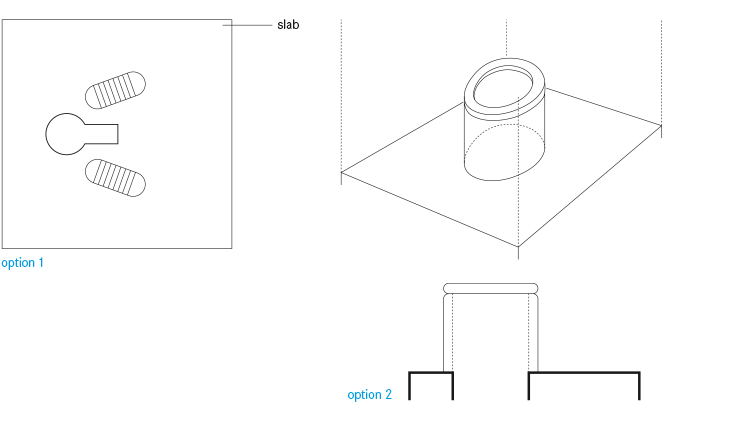
Executive Summary
A dry toilet is a toilet that operates without flushwater. The dry toilet may be a raised pedestal on which the user can sit, or a squat pan over which the user squats. In both cases, excreta (both urine and faeces) fall through a drop hole.
| In | Out |
|---|---|
Urine, Faeces, Anal Cleansing Water, Dry Cleansing Materials |
Excreta, Anal Cleansing Water, Dry Cleansing Materials |
Introduction
Here, a dry toilet refers specifically to the device over which the user sits or squats. In other literature, a dry toilet may refer to a variety of technologies, or combinations of technologies (especially pits).Design Considerations
The dry toilet is usually placed over a pit; if two pits are used, the pedestal or slab should be designed in such a way that it can be lifted and moved from one pit to another.
The slab or pedestal base should be well sized to the pit so that it is both safe for the user and prevents stormwater from infiltrating the pit (which may cause it to overflow). The hole can be closed with a lid to prevent unwanted intrusion from insects or rodents.
Pedestals and squatting slabs can be made locally with concrete (providing that sand and cement are available). Fibreglass, porcelain and stainless steel versions may also be available. Wooden or metal moulds can be used to produce several units quickly and efficiently
Health Aspects/Acceptance
Squatting is a natural position for many people and so a well-kept squatting slab may be the most acceptable option.
Since dry toilets do not have a water seal, odours may be a problem depending on the Collection and Storage/Treatment technology (see http://ecompendium.sswm.info/sanitation-technologies) connected to them.
Read some of our most visited factsheets on sustainable sanitation such as the one on menstrual hygiene management!
Operation & Maintenance
The sitting or standing surface should be kept clean and dry to prevent pathogen/disease transmission and to limit odours. There are no mechanical parts; therefore, the dry toilet should not need repairs except in the event that it cracks.
Dry toilets are easy for almost everyone to use though special consideration may need to be made for elderly or disabled users who may have difficulty. When dry toilets are made locally, they can be specially designed to meet the needs of the target users (e.g., smaller ones for children). Because there is no need to separate urine and faeces, they are often the simplest and physically most comfortable option.
Latrine Building
Introduction to Low Cost Sanitation Latrine Construction
This manual describes how to construct latrines.
CAWST (2011): Introduction to Low Cost Sanitation Latrine Construction. A CAWST Construction Manual. Calgary: CAWST URL [Accessed: 25.08.2014]Toilets That Make Compost
This book describes in an easy-to-understand and picture-based way how to construct three different low cost sanitation solutions, namely arborloos, fossa alterna and urine diversion toilets.
MORGAN, P. EcoSanRes (2007): Toilets That Make Compost . Stockholm: Stockholm Environment Institute URL [Accessed: 09.05.2019]Ecological Toilets
This book describes how to construct Arborloo toilets and how it can be upgraded to VIPs at a later stage.
MORGAN, P. EcoSanRes (2009): Ecological Toilets. (pdf presentation). Stockholm: Stockholm Environment Institute URL [Accessed: 09.05.2019]An Engineer’s Guide to Latrine Slabs
Providing sanitation for all is a major global challenge involving many complex issues. The user of a latrine however, will have more local concerns such as the condition of the latrine slab. This is one of the key components of the most common type of sanitary facility. This booklet highlights the design, manufacture and maintenance features that help to improve the safety and comfort of users.
REED, B. (2012): An Engineer’s Guide to Latrine Slabs. Leicestershire: Water, Engineering and Development Centre (WEDC) Loughborough University URL [Accessed: 08.10.2013]
